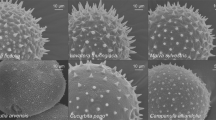Summary
In the Colorado Rocky Mountains the glacier lily Erythronium grandiflorum exhibits a striking dimorphism in pollen color and is commonly pollinated by the bumble bee Bombus occidentalis. We induced bees to visit sequences of flowers in a flight cage, and compared dispersal of distinctively-colored pollen and fluorescent pigment (“dye”) that the bee had picked up at a single donor flower. Nonparametric and parametric analyses showed that dispersal properties of pollen and dye differed; consistently less pollen was deposited and it was carried consistently shorter distances than dye. Dye thus does not provide an accurate means of assessing exacty where or how far pollen travels in this plant-pollinator system. On the other hand, both pollen and dye responded similarly to several experimental manipulations of donor and recipient flowers. Hence dye may well be of value for a qualitative investigation of how floral traits influence pollen dispersal.
Similar content being viewed by others
References
Campbell DR (1985) Pollen and gene dispersal: the influences of competition for pollination. Evolution 39:418–431
Handel SN (1983) Pollination ecology, plant population structure, and gene flow. In: Real L (ed) Pollination biology, Academic Press, Orlando, Florida
Lertzman KP, Gass CL (1983) Alternative models of pollen transfer. In: Jones CE, Little RJ (eds) Handbook of Experimental Pollination Biology. Van Nostrand-Reinhold, NY. pp 474–489
Price MV, Waser NM (1979) Pollen dispersal and optimal outcrossing in Delphinium nelsoni. Nature 277:294–297
Price MV, Waser NM (1982) Experimental studies of pollen carryover: hummingbirds and Ipomopsis aggregata. Oecologia (Berlin) 54:353–358
Thomson JD (1983) Component analysis of community level interactions in pollination systems. In: Jones CE, Little RJ (eds) Handbook of Experimental Pollination Biology. Van Nostrand-Reinhold, NY. pp 451–460
Thomson JD (1986) Pollen transport and deposition by bumble bees in Erythronium: influences of floral nectar and bee grooming. J Ecol (in press)
Thomson JD, Plowright RC (1980) Pollen carryover, nectar rewards, and pollinator behavior with special reference to Diervilla lonicera. Oecologia (Berlin). 46:68–74
Waser NM (1983) The adaptive nature of floral traits: Ideas & evidence. In: Real LA (ed) Pollination biology. Academic Press. pp 241–285
Waser NM, Price MV (1982) A comparison of pollen and fluorescent dye carryover by natural pollinators of Ipomopsis aggregata (Polemoniaceae). Ecology 63:1168–1172
Waser NM, Price MV (1984) Experimental studies in pollen carryover: effects of floral variability in Ipomopsis aggregata. Oecologia (Berlin) 62:262–268
Webb CJ, Bawa KS (1983) Pollen dispersal by hummingbirds and butterflies: a comparative study of two lowland tropical plants. Evolution 37:1258–1270
Author information
Authors and Affiliations
Rights and permissions
About this article
Cite this article
Thomson, J.D., Price, M.V., Waser, N.M. et al. Comparative studies of pollen and fluorescent dye transport by bumble bees visiting Erythronium grandiflorum . Oecologia 69, 561–566 (1986). https://doi.org/10.1007/BF00410363
Received:
Issue Date:
DOI: https://doi.org/10.1007/BF00410363




